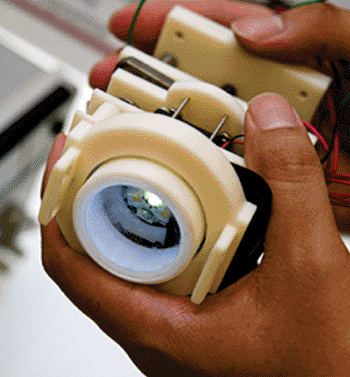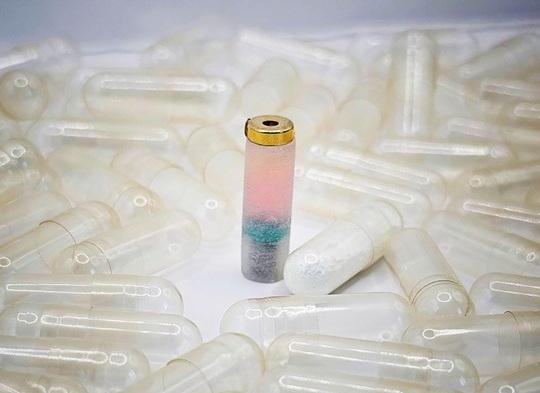Pathology Device Averts Repeated Breast Cancer Surgeries
|
By HospiMedica International staff writers Posted on 16 Jul 2013 |

Image: The prototype device applies an adhesive film to the breast tissue before examination (Photo courtesy of Will Kirk/homewoodphoto.jhu.edu).
A new tool will allow pathologists to quickly inspect excised breast tissue while the patient is still in the operating room (OR), reducing the need for a second surgery.
Developed by graduate students at Johns Hopkins University (Baltimore, MD, USA), the prototype device applies an adhesive film to the specimen breast tissue before it is sliced; the film thus holds the delicate tissue together, preventing damage to the samples during the preparation process. The result is a sample that can be clearly reviewed by a pathologist within 20 minutes of its removal, potentially eliminating the need for a second operation on another day. The low-cost system includes a reusable applicator and a proprietary disposable film.
“We spoke to breast cancer surgeons,” said Hector Neira, MSc, one of the student inventors. “They told us that they are desperate for something that will allow them to remove the tumor in its entirety the first time, so that the patient doesn’t have to come back for a second surgery.”
“I think the students have been incredibly creative in their development of this concept, and they are addressing a very real need in the field of breast cancer surgery,” added professor of Surgery Melissa Camp, who worked with the students. “Accurate assessment of margin status during the initial operation will lead to fewer reoperations, and this will be beneficial for patients in many respects. I look forward to their continued work!”
When most tumors are removed, pathologist can quickly flash-freeze the tissue and slice off paper-thin samples for microscopic examination; if the pathologist sees that cancer cells extend to the outer edge or margin of a sample, the surgeon is advised to remove more tissue from the patient. Breast tissue, however, poses a problem; it has a high fat content and does not freeze well, causing the samples to smear, form gaps, and become unsuitable for a quick review.
Related Links:
Johns Hopkins University
Developed by graduate students at Johns Hopkins University (Baltimore, MD, USA), the prototype device applies an adhesive film to the specimen breast tissue before it is sliced; the film thus holds the delicate tissue together, preventing damage to the samples during the preparation process. The result is a sample that can be clearly reviewed by a pathologist within 20 minutes of its removal, potentially eliminating the need for a second operation on another day. The low-cost system includes a reusable applicator and a proprietary disposable film.
“We spoke to breast cancer surgeons,” said Hector Neira, MSc, one of the student inventors. “They told us that they are desperate for something that will allow them to remove the tumor in its entirety the first time, so that the patient doesn’t have to come back for a second surgery.”
“I think the students have been incredibly creative in their development of this concept, and they are addressing a very real need in the field of breast cancer surgery,” added professor of Surgery Melissa Camp, who worked with the students. “Accurate assessment of margin status during the initial operation will lead to fewer reoperations, and this will be beneficial for patients in many respects. I look forward to their continued work!”
When most tumors are removed, pathologist can quickly flash-freeze the tissue and slice off paper-thin samples for microscopic examination; if the pathologist sees that cancer cells extend to the outer edge or margin of a sample, the surgeon is advised to remove more tissue from the patient. Breast tissue, however, poses a problem; it has a high fat content and does not freeze well, causing the samples to smear, form gaps, and become unsuitable for a quick review.
Related Links:
Johns Hopkins University
Latest Surgical Techniques News
- Minimally Invasive Endoscopic Surgery Improves Severe Stroke Outcomes
- Novel Glue Prevents Complications After Breast Cancer Surgery
- Breakthrough Brain Implant Enables Safer and More Precise Drug Delivery
- Bioadhesive Sponge Stops Uncontrolled Internal Bleeding During Surgery
- Revolutionary Nano Bone Material to Accelerate Surgery and Healing
- Superior Orthopedic Implants Combat Infections and Quicken Healing After Surgery
- Laser-Based Technique Eliminates Pancreatic Tumors While Protecting Healthy Tissue
- Surgical Treatment of Severe Carotid Artery Stenosis Benefits Blood-Brain Barrier
- Revolutionary Reusable Duodenoscope Introduces 68-Minute Sterilization
- World's First Transcatheter Smart Implant Monitors and Treats Congestion in Heart Failure
- Hybrid Endoscope Marks Breakthrough in Surgical Visualization
- Robot-Assisted Bronchoscope Diagnoses Tiniest and Hardest to Reach Lung Tumors
- Diamond-Titanium Device Paves Way for Smart Implants that Warn of Disease Progression
- 3D Printable Bio-Active Glass Could Serve as Bone Replacement Material
- Spider-Inspired Magnetic Soft Robots to Perform Minimally Invasive GI Tract Procedures
- Micro Imaging Device Paired with Endoscope Spots Cancers at Earlier Stage
Channels
Critical Care
view channel
AI Heart Attack Risk Assessment Tool Outperforms Existing Methods
For decades, doctors have relied on standardized scoring systems to assess patients with the most common type of heart attack—non-ST-elevation acute coronary syndrome (NSTE-ACS). The GRACE score, used... Read more
'Universal' Kidney to Match Any Blood Type
Blood-type incompatibility has long been one of the greatest obstacles in organ transplantation, forcing thousands of patients—particularly those with type O blood—to wait years longer for compatible donors.... Read morePatient Care
view channel
Revolutionary Automatic IV-Line Flushing Device to Enhance Infusion Care
More than 80% of in-hospital patients receive intravenous (IV) therapy. Every dose of IV medicine delivered in a small volume (<250 mL) infusion bag should be followed by subsequent flushing to ensure... Read more
VR Training Tool Combats Contamination of Portable Medical Equipment
Healthcare-associated infections (HAIs) impact one in every 31 patients, cause nearly 100,000 deaths each year, and cost USD 28.4 billion in direct medical expenses. Notably, up to 75% of these infections... Read more
Portable Biosensor Platform to Reduce Hospital-Acquired Infections
Approximately 4 million patients in the European Union acquire healthcare-associated infections (HAIs) or nosocomial infections each year, with around 37,000 deaths directly resulting from these infections,... Read moreFirst-Of-Its-Kind Portable Germicidal Light Technology Disinfects High-Touch Clinical Surfaces in Seconds
Reducing healthcare-acquired infections (HAIs) remains a pressing issue within global healthcare systems. In the United States alone, 1.7 million patients contract HAIs annually, leading to approximately... Read moreHealth IT
view channel
Printable Molecule-Selective Nanoparticles Enable Mass Production of Wearable Biosensors
The future of medicine is likely to focus on the personalization of healthcare—understanding exactly what an individual requires and delivering the appropriate combination of nutrients, metabolites, and... Read moreBusiness
view channel
Philips and Masimo Partner to Advance Patient Monitoring Measurement Technologies
Royal Philips (Amsterdam, Netherlands) and Masimo (Irvine, California, USA) have renewed their multi-year strategic collaboration, combining Philips’ expertise in patient monitoring with Masimo’s noninvasive... Read more
B. Braun Acquires Digital Microsurgery Company True Digital Surgery
The high-end microsurgery market in neurosurgery, spine, and ENT is undergoing a significant transformation. Traditional analog microscopes are giving way to digital exoscopes, which provide improved visualization,... Read more
CMEF 2025 to Promote Holistic and High-Quality Development of Medical and Health Industry
The 92nd China International Medical Equipment Fair (CMEF 2025) Autumn Exhibition is scheduled to be held from September 26 to 29 at the China Import and Export Fair Complex (Canton Fair Complex) in Guangzhou.... Read more














